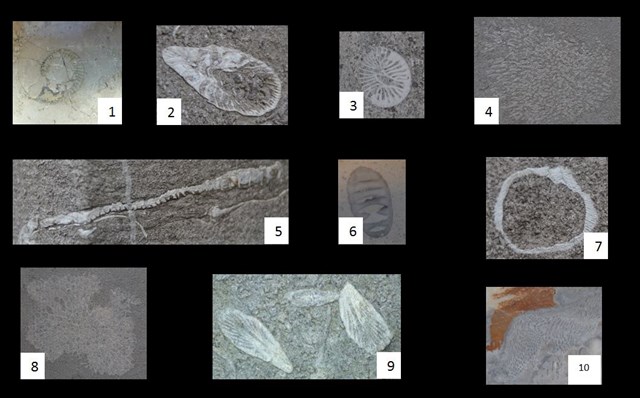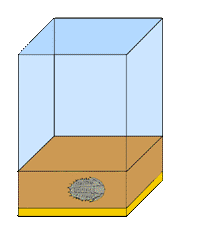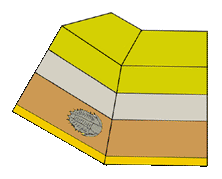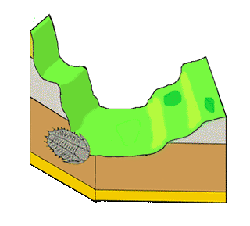[ITA]
Ho passeggiato spesso per il centro di Udine, ma prima d’ora non avevo mai osservato attentamente i muri delle case, i davanzali, le scale o le corti dei palazzi. Dopo le nostre due prime “earthcaches” sui fossili, siamo andati spesso a cercarne lontano da casa. Poche persone hanno però notato la moltitudine di fossili antichi milioni di anni che ci circonda anche qui..
Molti edifici sono costruiti con diversi materiali: usiamo differenti tipi di rocce sedimentarie che devono la loro bellezza al colore ma anche alla presenza di fossili. Questi, gran parte dei quali tagliati a metà, si rivelano chiaramente grazie al taglio ed alle operazioni di pulizia delle rocce sedimentarie.
I fossili che sovente troviamo in questi “earthcaches” sono prevalentemente residui di coralli, conchiglie, crinoidi, bryozoe e lumache. Alcuni esempi di questi fossili sono portati in seguito:

Cos’è un fossile?
Un fossile compare quando i resti o le tracce di un animale o di una pianta vengono seppelliti da successive sedimentazioni. Grazie alla sovrapposizione di sedimenti, la pressione aumenta ed il processo di fossilizzazione può avere inizio. Il residuo animale o vegetale viene infatti rimpiazzato da un minerale che si mantiene all’interno della roccia. Con il tempo, il fossile, grazie all’erosione ed ai movimenti tettonici, può giungere alla superficie. I fossili possono preservarsi anche in altri materiali, come la resina fossilizzata o il ghiaccio.
Come fa un fossile a rivelarsi nella roccia sedimentaria?
Quando un animale o una pianta muore, l’attività di elementi naturali come saprofagi e batteri fa sì che solo le parti rigide si mantengano. Nel nostro esempio le parti rigide si preservano sul fondo del mare.

Con il trascorrere del tempo, tali parti rigide vengono ricoperte da sedimenti come sabbia, fango, cenere vulcanica, lava, etc.

L’accumulazione continua di sedimenti porta ad un aumento della pressione nelle stratificazioni più basse. L’azione del tempo e di questa pressione trasforma i sedimenti più bassi in pietra. Quando l’acqua ricca di minerali filtra attraverso le rocce plasmate nelle quali i residui rigidi sono incastonati, questi minerali penetrano i resti solidi. Nel corso di milioni di anni, le parti rigide si dissolvono: le molecole animali o vegetali sono rimpiazzate da molecole di calcite o di altri minerali che riflettono la forma esatta delle parti rigide della pietra.

Da milioni di anni le piattaforme continentali sono in movimento: i loro scontri reciproci hanno dato origine alle montagne. Quelli che un tempo erano letti marini sono emersi trasformandosi in terraferma.

Attraverso erosione, terremoti o attività estrattiva, questi fossili sono venuti in superficie.

I disegni soprastanti sono stati riprodotti con il permesso del sito, in cui si trovano ulteriori informazioni in merito ai fossili: http://www.fossils-facts-and-finds.com
L’obiettivo
Per registrare questo “earthcache” dovrai trovare diverse risposte durante una camminata attraverso il centro di Udine. In ognuna delle posizioni suggerite dalle coordinate date cercherai le risposte alle domande che trovi qui sotto.
L’”earthcache” potrà essere registrato dopo che avrai mandato le risposte alle seguenti domande attraverso il tuo profilo.
Domanda 1:
N46 03.483 E 013 14.727
Nel WP 1 guarda in basso: troverai alcuni esemplari di una tipologia di fossile nelle mattonelle. Dai il nome e misura le dimensioni di uno di questi fossili.
Domanda 2:
N46 03.598 E 013 14.405
Nel WP 2, al numero 22B c’è una particolare forma di fossile tagliato a metà. Ha le sembianze di lava fluida o di impronta?
Domanda 3:
N46 03.747 E 013 14.205
Il WP 3 contiene una pietra di circa 30cm x 30cm nel muro. Descrivi il colore della pietra e che tipo di fossile può essere osservato qui.
Domanda 4:
N46 03.800 E 013 14.109
Al WP 4 prendi le scale. Percorri la fila centrale di mattonelle bianche. Giungi sino alla undicesima mattonella. Quanti grandi fossili si possono osservare qui? Descrivi la loro forma. Ora torna alla panchina e descrivi:
A. Dove si trovano i fossili sulle panchine?
B. Puoi affermare che i fossili sono concentrati in alcune zone o si distribuiscono equamente?
C. Quali tipologie di fossili si trovano prevalentemente?
Domanda 5:
N46 03.826 E 013 14.152
Al WP 5 vedrai delle colonne bianche. Guarda la colonna 12 alla base e la 20 nel lato destro.
A. Quali fossili si possono osservare qui?
B. Sono uguali o differenti per ogni colonna?
Ringraziamo il Mattia per l'aiuto e la traduzione in italiano.
[ENG]
Many times I have walked through the center of Udine. Never before I looked closer to the walls of the houses, sills, stairs or halls of buildings. After our first two earthcaches about fossils we went fossil hunting further away from home. Very few people have noticed the millions of years old fossils that surround us here.
Many buildings are made with different materials. So we use different types of sedimentary rock that derive their beauty from their color, but also by the presence of fossils. These fossils, mostly cut in half, are clearly revealed by the cutting and polishing of this sedimentary rock.
The fossils that we often find in this earthcache are mostly remnants of corals, shells, crinoids, bryozoans and snails. Examples of these fossils are shown below:

What is a fossil?
When the remains or traces of an animal or a plant are buried by sediments, a fossil can arise. Due to the accumulation of sediments, the pressure is increased and a fossil process becomes in motion. The residue is thereby replaced by a mineral remaining in a rock. Over time, the fossil can by erosion or tectonic movements may come back to the surface. Fossils may also preserved in other materials such as fossilized resin or ice.
How does a is a fossil arise in sedimentary rock?
When an animal or plants dies the elements of nature such as scavengers and bacterias make sure that only the hard parts remain. In our example, the hard parts remains on the bottom of the sea.

As time passes, the hard parts are covered with sediments such as sand, mud, volcanic ash, lava, etc ...

As sediments accumulate each other, the pressure is greater in the lower layers. Over time the bottom sediments will change in to stone by the pressure. When mineral rich water seeps between the shaped stone where the hard remains are buried, these minerals penetrate the hard remains. In the course of millions of years the hard parts dissolve and the molecules are replaced by molecules of calcite or other minerals so as to reflect the exact shape of the hard parts in the stone.

As the continental plates were in motion millions of years ago they sometimes clashes with each other and mountains arose. So former sea beds came up and became dry land.

By erosion, earthquakes or mining, these fossils came to the surface.

The above drawings were reproduced with permission from the following site where you can find more information about fossils: http://www.fossils-facts-and-finds.com
The task
To log this earth cache you will have to find answers during a walk through the city center of Udine. At each location at the given coordinates you are looking for the answers at the questions below.
The earthcache may be logged after you have sent the answers to the following questions through our profile.
Question 1:
N46 03.483 E 013 14.727
At WP 1 look down you'll find fine specimens of one kind of fossil in the tiles. Give the name and measure the size of one of these fossils.
Question 2:
N46 03.598 E 013 14.405
On WP 2 at number 22B there is a special form of a half cut fossil. Does it looks like flowing lava or a footprint.
Question 3:
N46 03.747 E 013 14.205
WP 3 contains a stone of about 30cm by 30cm in the wall. Describe the color of the stone and what kind of fossils can be seen here?
Question 4:
N46 03.800 E 013 14.109
On WP 4,take the stairs. Take the middle row of white tiles between the entrance and step eleven tiles far. How many big fossils can be seen here and describe their shape. Now go over to the benches and describe:
A. Where are the fossils located in the benches.
B. Would you say the fossils are concentrated or equally divided?
C. What kind of Fossils do you find here the most.
Question 5:
N46 03.826 E 013 14.152
On WP 5 you will see some white pillars. Look at pillar 12 at the foot and pillar 20 at the right side.
A. What fossils can be seen here?
B. Are they the same or are they different on each pillar?

